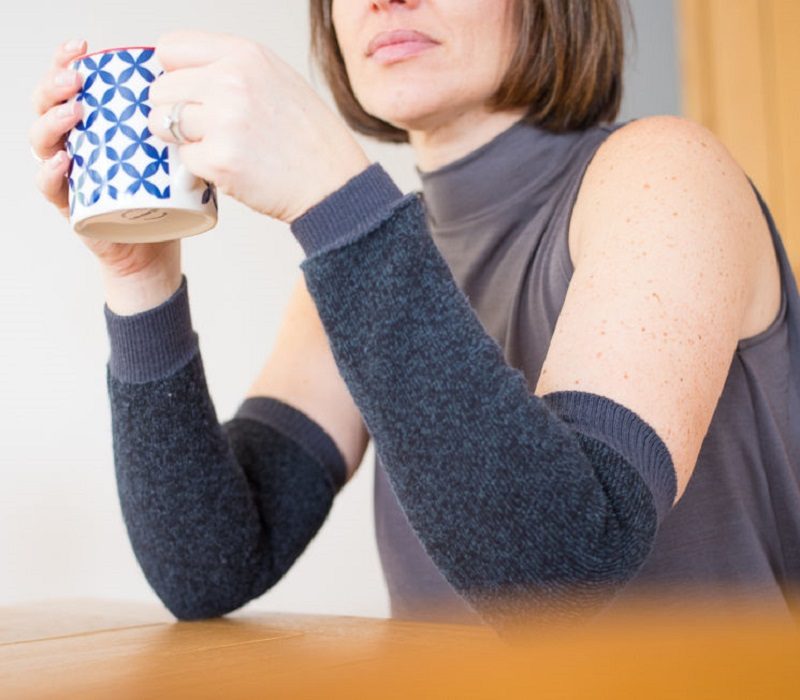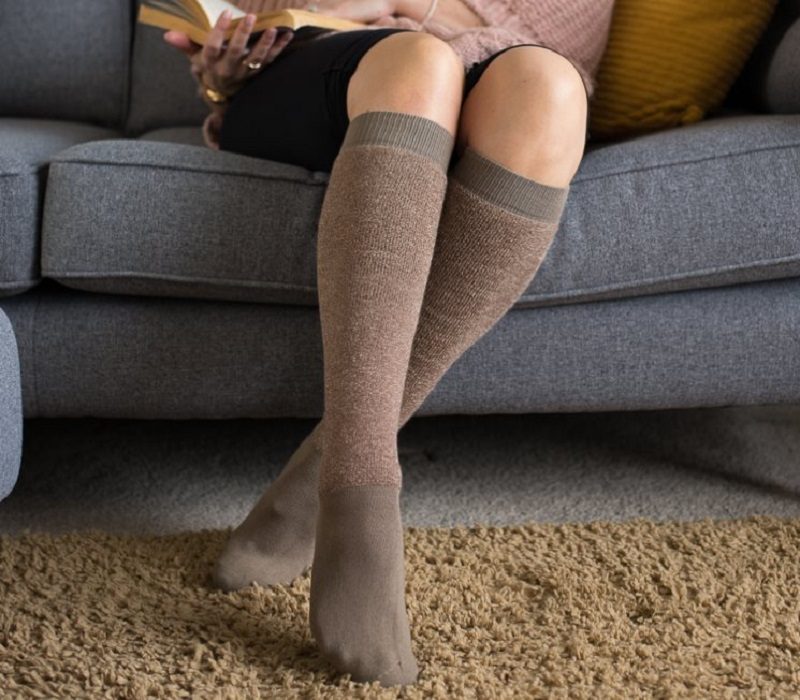
Setting up a business to help myself and millions of others with thin skin
This is an updated post from our archives. Peter Thornton, affected by thin skin, founded DermaTuff to produce protective socks and sleeves made from Kevlar®. These products help individuals with fragile skin maintain an active lifestyle by preventing skin tears and injuries.
Across the world, it’s estimated that millions of people are affected by problems associated with having thin skin, often because of a disability. For those with it, they can become consumed with the fear of dramatically tearing their skin and severely injuring themselves.
Understanding Thin Skin and Its Challenges
Thin skin, often resulting from aging, certain medications, or medical conditions, can lead to frequent skin tears and bruising. This fragility makes daily activities challenging and increases the risk of injuries.
DermaTuff’s Innovative Solution
- Protective Wear: DermaTuff offers socks and sleeves crafted from Kevlar®, a material known for its strength and durability, providing a protective layer against potential skin injuries.
- Comfort and Usability: Designed to be lightweight and breathable, these products ensure comfort for daily use, allowing individuals to continue their routines without fear of skin damage.
- Wide Applicability: Suitable for the elderly, individuals on long-term steroid therapy, or those with conditions like Ehlers-Danlos Syndrome, DermaTuff’s products cater to a broad audience in need of skin protection.
For more information or to purchase, visit the DermaTuff website.
Original post follows:
Sufferer Peter Thornton knows all too well how it can affect someone’s life. That’s why he set up DermaTuff, which makes Thin Skin Protection Socks and Sleeves for people with thin and fragile skin. They enable people with the condition to carry on their normal lives inside the house, outside the house, in the garden or indeed anywhere.
He believes that the condition of ‘thin skin’ should be set up as a recognised disability because it is a condition that must be permanently lived with.
Can you tell Disability Horizons readers a little about yourself, your disability and the problems you have experienced with thin skin?
I first started to suffer from thin skin and the consequent skin tears when I was in my early 60s. I kept an old car in a large garage that I had at my home and was walking around it one day when I inadvertently walked into one corner of the rear bumper. I looked down at my left leg to see a large skin laceration just below the knee.
The collision had torn away a flap of skin about three inches long and one inch wide, and blood was flowing profusely down my leg. I roughly wrapped the skin flap in a bandage and then drove myself to the local hospital A&E.
No other patients were waiting so the nurse attended to me at once. “You’ve got a skin tear,” she said at once. “Have you had one before?” I said that I had not, and she took me into casualty immediately and dressed it. After that, I had to go back to casualty every three days for about four weeks so it could be re-dressed.
Once that had healed, I experienced another skin tear within about four or five weeks. The same story was repeated and so it continued. I took my family on holiday to northern France and sightseeing around the streets of Morlaix one afternoon. I carelessly walked into a low bollard and received a really serious skin tear to my left leg. Again, I went to the hospital and spent about three hours there with my family.
Returning home from this holiday, I went to see a dermatologist. He told me; “you have thin skin, probably made worse by the fact that you have to take hydrocortisone because of your asthma. There is nothing you can do about it, except be more careful!”
I decided that I would have to do something myself to solve the problem and, at the same time, solve the problem for millions of other sufferers.
How has this affected you and what adjustments have you had to make?
Initially, I just tried to be extremely careful. But this was unsuccessful, so I became very nervous about moving around and again damaging my legs.
I went on a skiing holiday to Alpine France and received an extremely serious skin tear on the first day. I did no more skiing during that holiday. It began to really impinge on how I lived my life. I was always aware of it.
What was the plan with DermaTuff and how did you go about setting it up?
Some sort of protective clothing seemed to be the answer to millions of people’s problems. But there was nothing on the market. So, with no other option out there, I did the obvious thing and bought some shinpads for my next skiing holiday.
Suffice to say, they did not work. The shinpads were too rigid and inflexible, would not stay in position, did not protect the rear of my legs, and were much too bulky.
I knew I had to do something, to find a solution. So I met with my now business partner, Nick Pitts, and worked to invent something.

Can you tell us about DermaTuff’s products, how they work and their benefits?
After lots of discussions, we concluded that a pair of socks and a pair of sleeves made of woven Kevlar thread would probably be thin and light enough to be wearable day-to-day and sufficiently protective at the same time.
Kevlar® is a very famous fibre manufactured by USA brand DuPont. It’s used to make a variety of different clothes, accessories and equipment cut or stab resistant. As such, it’s used a lot in body amour. It’s also lightweight, durable and very strong.
The yarn that we use is a high proportion of Kevlar® spun together with a quality nylon fibre. In our experience, this blend gives the best impact resistance.
Once we had decided on the yarn, we researched a suitable Kevlar-based yarn and suitable sock manufacturers who were located in the UK. We had many trial products manufactured and then tested for performance in the UK. The results were excellent, dramatically lowering the number of skin tears that were normally experienced as a result of an impact.
At the same time, the products were found to be very comfortable and wearable. Unlike comparative products, they were lightweight and comfortable. Our DermaTuff Protection Socks and Sleeves are designed to be cool in summer and warm in winter.
DermaTuff’s products are aimed at older people but have a number of uses. How can they be used and who are the most useful for?
They can be used just like any other pair of stockings. They apply a small amount of pressure to the legs, which prevents them from falling down. It works the same way for the sleeves to keep them in position.
We frequently hear how Dermatuff products have allowed users to get back to activities they thought were in the past, whether it be out walking or taking part in a sporting activity. Exercise is so important for you when you are older in order to keep your muscles in good condition
Indeed, we know of one young chap who wanted to play football but couldn’t because of the rare condition Ehlers-Danlos Syndrome, which caused him to have very thin skin. We manufactured some smaller sized DermaTuff Socks for him that have enabled him to once again play with his friends!
Other disabilities that can cause or exacerbate thin skin include the long-term use of steroids or blood thinners (such as warfarin), celiac disease (where a person’s body cannot tolerate wheat, dairy or yeast) and focal dermal hypoplasia, which causes abnormalities with a person’s eyes, skeleton, face and eyes.
We have thoroughly trialled our products, as has the Research Design Service at the Royal Devon and Exeter Hospital. They are easy to use and offer a high degree of protection for people with thin or fragile skin on their legs and arms.

You talk on your website about people living longer than ever. What are your thoughts on provisions for older people, particularly those with disabilities, in our modern world?
As a matter of common sense, if cheap and inexpensive means can be found to prevent expensive and serious and painful injury for older people, then this has to make total sense.
Our socks and sleeves cost £30 per pair, plus VAT and shipment of £3.50. It has been estimated that the cost of repairing one skin tear is about £300 to the NHS, and the average vulnerable person suffers 1.7 skin tears per year. Two pairs of our Thin Skin Protection Socks would cost £67 and give protection for at least two years. During this same period, the vulnerable person could have experiences 3.4 skin tears costing £1,020 to repair.
It’s not just the cost that is a risk for people with skin tears – they can lead to infections, pain and chronic wounds, especially if untreated.
Can you tell us about your plans for the future, for yourself and your business?
Our products are inexpensive and very effective. They are patented and we wish to make them available via the National Health Service, and direct sales throughout the UK and around the world.
A very great deal of suffering and cost could be prevented in total.
By Peter Thornton
To find out more about DermaTuff’s range of products, visit the DermaTuff website.
Several products that can benefit people with thin skin by offering protection, hydration, and support:
1. Protective Wear
- Arm and Leg Sleeves: Protect arms and legs from cuts and bruises during daily activities.
- Kevlar® Socks: Similar to DermaTuff, these socks shield feet and ankles from tears and abrasions.
- Compression Garments: Provide support and reduce the risk of injuries while improving circulation.
2. Moisturizing Creams and Lotions
- Barrier Creams: Create a protective layer over the skin to prevent irritation and moisture loss.
- Hydrating Creams: Products with ceramides or hyaluronic acid, like CeraVe or Eucerin, help maintain skin moisture and reduce fragility.
- Vitamin A or Retinol Creams: Help improve skin thickness over time but should be used under medical supervision.
3. Adhesive-Free Bandages
- Designed for delicate skin, these bandages use silicone-based adhesives or gentle wraps to prevent damage during application or removal.
4. Silicone Gel Sheets
- Promote healing of scars and wounds while protecting fragile skin from additional stress.
5. Skin-Friendly Clothing
- Seamless, soft, and hypoallergenic fabrics (like bamboo or silk) reduce friction and irritation.
6. Sun Protection
- Broad-spectrum sunscreen with SPF 50 to shield thin skin from UV rays, which can exacerbate thinning.
7. Foam Padding
- Protective padding for high-risk areas like knees, elbows, and forearms, used during physical activities.
8. Nutritional Supplements
- Collagen Peptides: Support skin elasticity and repair.
- Vitamin C and E: Help with skin repair and improve its resilience.
9. Skin-Friendly Cleaning Products
- Mild, fragrance-free soaps and cleansers that prevent further drying and irritation of thin skin.
Suggested Product:
If you’re interested in products tailored for disability needs, explore options at Shop Disability Horizons.
These products help people with thin skin live comfortably, reduce the risk of injury, and promote healthier skin.
Frequently Asked Questions
- How do DermaTuff products help prevent skin tears? The Kevlar® material provides a strong barrier that absorbs impacts, reducing the risk of skin injuries.
- Can I wear DermaTuff socks daily? Yes, they are designed for daily use and are both comfortable and breathable.
- Are there different sizes available? DermaTuff offers various sizes to ensure a snug and secure fit for all users.
Originally posted on 20/04/2018 @ 12:01 am